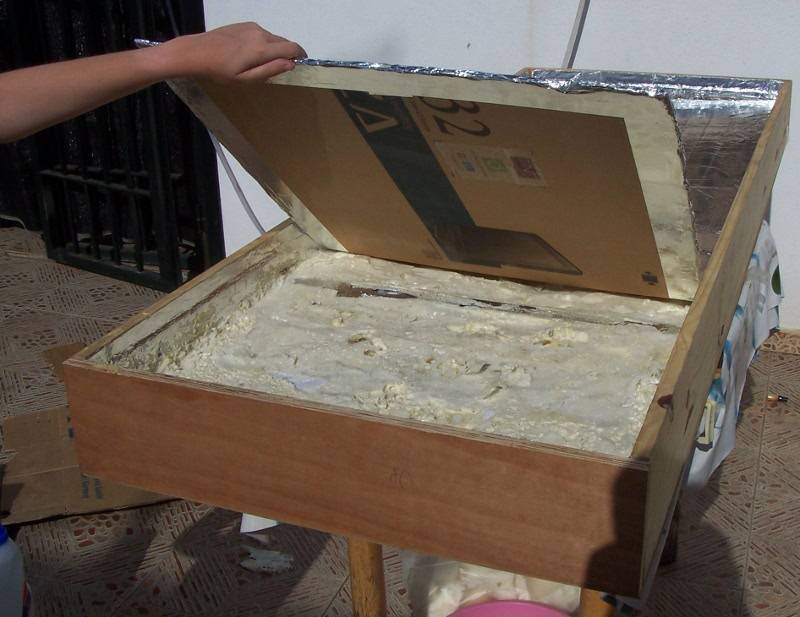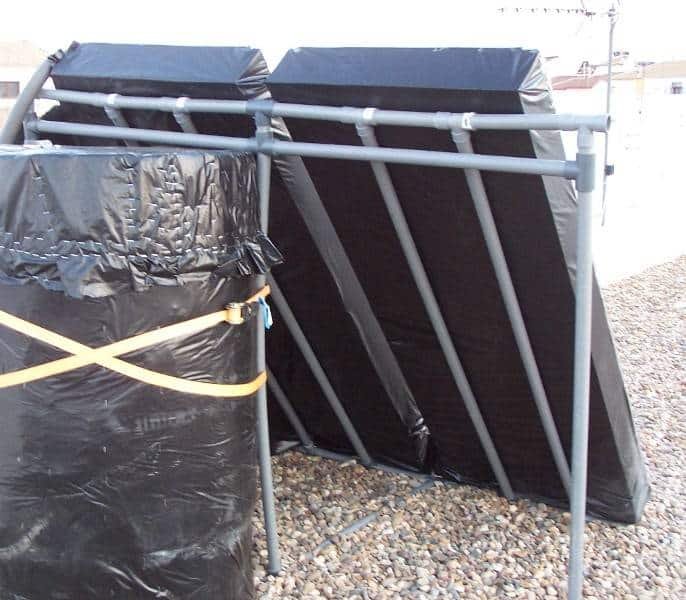
Let's easily build a flat collector solar collector box.
While it is important to get it right, and take good care of the insulation, it is not the most important component of the entire system.
If the water circulation is good and circulates when it should, and the tank accumulates and conserves energy well, the collector, however regular it may be, will be well used.
To make our home collector, we need to know, which consists of the following parts:
The box must by necessity be slightly larger than the solar collector.
The logical thing is to make the box first and then the custom collector.
But if you have already made the collector, you must make the box as the collector is inside, and its terminals come out of the box. Or they can drag on to get out of it.
I am not going to elaborate on the details of how to assemble a box, because this is not a DIY website.
It is very simple, it is as if we wanted to build a shallow closet without doors.
My box is made of pine wood, and I will varnish it with a special boat varnish (it provides a coverage guarantee for 10 years)
The depth will be just enough to introduce the insulating material and the copper collector inside.
And we can cover the bottom of the box with another wood, or simply with 1 or more wood veneers of those that are used in cabinets.
What we are looking for with covering the rear part is nothing more so that the insulating material is not directly exposed to the elements (sun and humidity).
I have used quite large internal brackets, so that the box is solid.
If you use internal brackets, you have to consider their position, which then does not occupy the place where the collector bars need to come out.


You can use anything that is not especially flammable.
Among the things you can put in, cardboard is quite viable.
The cardboard is not flammable, but withstands heat very well, it will not ignite if there is no fire inside.
A specific material is not essential, if we do not have good quality materials we can make the box deeper to accommodate more thickness of insulating materials.
That is, if we cannot put quality, we will put quantity, to achieve the same thing at the end of the day :-p
I have put as a first layer, a little expanded polystyrene, the typical white cork.
If you look at the photo, first I have put some small squares that will be the support of the collector.
The polystyrene is 4mm, and I have glued it with white carpenter's glue.
And it looks like this:

On top of the polystyrene, I have put several layers of aluminum foil glued with the same white glue as before.
Although aluminum is a temperature conductor, here it serves as a shield, and it will not drive the temperature inward because it meets the insulation.
It can be put or not, each one can do it at their own discretion.



Here I have the box lying down, and I have already put the support for the collector.
The support is 2 transverse wooden bars.
You don't need brute force, some sticks with some small squares. (the squares I already put them before)
And here I finish with the interior insulation.
Polyurethane foam, be careful with the foam, which swells more than it seems.
Gradually add globs, we wait several minutes and continue filling.
In the end we will have a collection of lumps and mountains. We will cut out everything that stands out to leave a nice mattress.
Take into account if the space is very large and deep, we will spend much more foam.
I used more foam than expected, I should have made the box shallower.

I'm not going to stop now to explain what the absorber is for.
We build it and continue.
We can make it of sheet metal, aluminum, anything that traps and conducts the temperature well.
I did not have access to almost anything, and I built it with a cardboard sheet, and lined with aluminum foil.

Notice that the absorber covers the support I made for the collector.
It does not matter, because both the collector and the absorber will be fixed to that support.
Of course, it is better to make some marquitas with pencil or labeling, for when you go to screw things we know where the bars are.
And this is such that so.

Installing the collector in the box
The collector, which is my, made up of welded bars, or a spiral hose, whatever, will be attached to the absorber.
This is how the collector is mounted, only missing a little paint and the screen.

The collector bars, through which the water passes, and the absorber, need to be very closely in contact.
Do you remember when we are winter in bed, and we put our feet in those velvet lined rubber bags filled with hot water, you press against the bag to feel the heat more closely? well that.
If those bags were aluminum instead of rubber with velvet, we wouldn't even be able to put our feet on them.
A lot depends on this contact and its materials that the heat is noticeable and fast in the copper tubes, and the performance of the solar collector box is very efficient.
That it is homemade does not mean that we do it well.
A good trick so that the tubes (whether made of copper or not), and the absorber (preferably this one if it has to be metallic), hug each other well and transmit the temperature quickly, is this.

Do you see how the subject goes?
A picture is worth a thousand words.


These grips, typical for gripping the pipes on the wall, are screwed to the wooden bars that we put before.
And the aluminum makes an "ohm" shape to gain more contact with the tube.
INCORECT way to join the copper tube with the absorber

CORRECT way to join the copper tube with the absorber

I have read that the industry tends to weld tubes with the absorber, even with state-of-the-art technology to make such welds with ultrasound.
Puff !!! I stay with the homemade technology hehehehehehe
No mysteries.
Matte black paint, call it ash color or whatever you want, but no gloss paint.
Preferably anti-heat paint.
Anti-heat paint is a special paint to withstand high temperatures.
If it's spray paint, it will be easier to apply.

As shown in the following photo, this is how everything is finally painted (only a small finish is missing in the outline)
You can also see in the same photo, the outlet of the collector out.
The outlet of the copper tube in the upper part has a "T" to fit a thermal probe inside.
The outlet of the copper tube at the bottom has nothing, just its threaded connector.

It is very important to make a small hole in the bottom of each box.
In each of the boxes, always.
It is to avoid excess pressure that could damage the case or the acrylic or glass screen.
One thing is the greenhouse effect, and another is that it is totally airtight.
Very hot air and water will come out of this hole.
The water will be the product of condensation, and we are not interested in it remaining inside, fogging up our screens.


On each internal side of the box, we place 1 thin strip nailed with nails.
These 4 slats will be the support and settlement to put and seal the screen, which will finally close our box.
Optionally we can "dress" these slats with some insulation, which at the same time cushions the settlement of the screen.

The transparent screen or cover that will allow the entry of solar radiation, and at the same time will prevent the exit of heat (greenhouse effect), can be made of glass or acrylic.
I have preferred to use alveolar polycarbonate, for 4 reasons:
You just need to seal with silicone and make an outer frame with aluminum adhesive.

Good testing…. a preview with the box open and without circulating water ...
That it reaches almost 100 degrees in a very short time, is already a good sign.


If we are going to install the collectors on a flat surface, we do not need a structure as complex and expensive as aluminum.
I have built a homemade support based on pvc pipes.
Playing with unions based on "tees" and elbows, we will assemble a solid structure.
We will have to consider grabbing it somehow securely to the ground, and the plates will need to be attached somehow to the structure as well.
It is important to make several holes in the pvc pipes in the place where the rainwater cannot enter.
The reason for applying these holes is to allow the air to come in and out freely, so that the hot air inside does not deform the structure.

